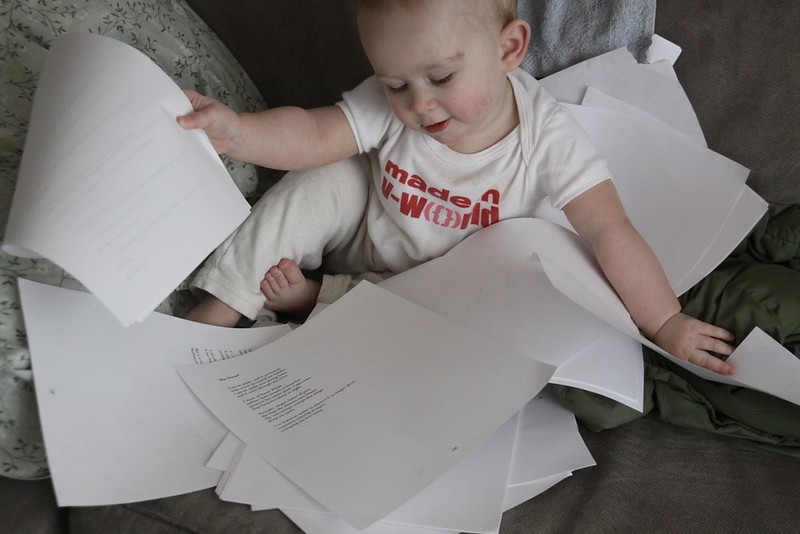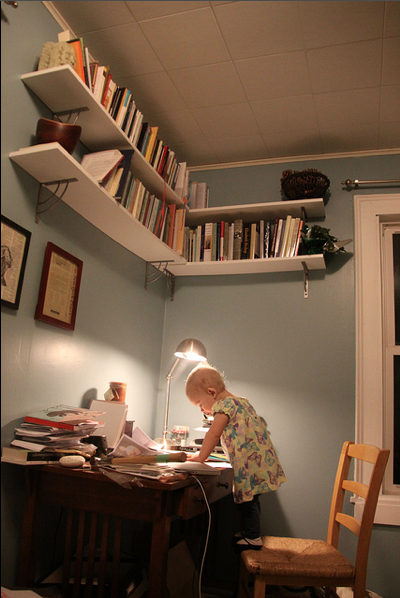Molly Sutton Kiefer spoke with us about where she writes and what role her surroundings play in her work. She’s the author of two chapbooks and the recent lyric essay Nestuary, which was published this year by Ricochet Editions (an imprint of Gold Line Press).
Could you tell us about your work in general—what you make, what your making thinks or talks about or performs, what kinds of things you want to or are trying to make?
I write mostly poems and poem-things. Little fragments I try to tie together into a whole. I’ve recently had this strange convergence: as an undergraduate, I thought I would become a memoirist and then as a graduate student, I studied poetry. With Nestuary, this, along with other iterations of creative nonfiction, have gotten the chance to smash up and meld. When I’m in my deepest periods of quiet, the ones that give me a panic but I know will always end, I often make other things with my hands: knit, sew, garden. I dabble a lot, so you could find me taking an embroidery class or a letterpress class or studying photography.

Do you routinely get to spend time making or focusing only on your creative life? What do you do on a day-to-day level, and how does (or doesn’t) making figure into that?
There are so many ways one could use motherhood as a comparison to the writing experience: oh, the long labor and the birth of the book! Each book is a different baby! I think, of all these ways we can cross-hatch the two experiences, the comparison of “once you finally get the hang of it, everything changes” is the one that resonates the most with me. As soon as I find myself having a contented writing routine, it changes, on a whim. It’s all so different: when I was working on my thesis manuscript, I would creep downstairs after a late night nursing with my daughter, and I’d write a poem or two, you know, in that confused fog of half-sleep, where poetic connections were loosest. Nestuary was written in a burst and revised quickly too. At this very moment, I have this packet of writing notebooks and each notebook, a beautifully decorated Moleskine I’ve either collected from the shop at Minnesota Center for the Book Arts or etsy, represents a different writing project: the one with the hot air balloon is where I am working on my most urgent manuscript, which is about death and the afterlife and grief; there’s another with a whale splayed open that are my Alaska poems, and on. Because my daughter is in preschool, I have this space of time in the mornings solo with my newly toddling son, and I’ll maybe watch a documentary on a topic relevant to one of my projects–something on skeletons found in the Sahara or commercial fishing in the Cook Inlet. I’ll take notes; I’ll see if I can transform those notes into a poem later at night. I’ll try to capture as much as I can in fragments. And now that I am a mother, whose arms are often full of diapers or little toys or sixty pounds of offspring, I have learned to work out poems or goals in my head, which is awfully difficult to pin down when I get the chance, but still a good part of the process. One of my teachers, Oliver de la Paz, said he’ll often spend the first chip of his writing time working on revision–this work can help him enter generating. For me, it’s often reading a good book of poems–I love it when I finally cannot read another page because I have to scurry away and make too! I am thankful to those poets, and anything else that can help me cross that bridge from everyday to creating from the everyday.
Tell us about where you work—the city, the neighborhood, your tours around the local geography of your workroom, your desk, your computer, your notebook, your equipment. What’s it feel like?
There’s this little blue room off our dining room–blue, painted by my husband in a color I picked, blue, because Minnesota winters are so grey–and it has a futon (still guest-worthy, but so cramped) and books upon books upon books and my desk, which is always such a mess. I’m ridiculously lucky in that my husband does understand the need for my own space, though I rarely use it as I should. More often, you can find me mobile, writing with a babe in my lap, my notebook askew. I love my poetry dates–museums and wildlife sanctuaries and coffee shops and the like. Most often, much to my husband’s chagrin, you can find me pecking away at the dining room table. All of these rooms in our house have books, floor to ceiling, and I think that’s something that brings me comfort.
I’ve become more particular about equipment too; I know most writers can relate to this. A specific pen–I had used one ink pen for the last, oh, twenty years, and recently, I’ve switched to a specific grey ballpoint. Ballpoint! Not long ago I never would have heard of such a thing! I remember, just before getting married, Carolyn Forche gave me a fountain pen, told me to use it to write poems on my honeymoon. Before, I could only use narrow-lined notebooks (oh, those fat, wide-ruled pages are my enemy!), but now I prefer lineless entirely, so I can write in the tiniest of handwriting, can doodle, can clip images from magazines that will help keep me in that mental space.
How does your space reflect or inform the work you’re able to do? How does it inform your most recent work?
Nestuary is very much a physical-body oriented piece, and even towards the end, I consciously wrote about where I was while writing: engorged, pumping, hunched on the floor of our living room, writing the last pages of the manuscript. It was spring of last year, and winter was very much so on my mind, as the light from the street corner filtered through our window and I thought of Hestia and her hearth. I’m not rooted into my neighborhood and town as I’d like to: I only worked outside the home here for one year, so most of my time outside our small sphere, like my husband’s, is spent commuting. I have more writerly connection to the Twin Cities than here, which is fine; I have a drive to work myself into that space.
 But place is crucial to what I do. It lives inside of me. When I write of Alaska, the time I spent there rises up. When I write a poem about my father-in-law’s illness, I am back in those rooms of that house, can feel and smell. So it isn’t as much about the immediate space, but about the imagined space, about what can grow up around me. Perhaps this is why so much of my writing happens without the lights on–not to discourage others from approach, but so that it spills into me. So much of my landscape has children in it. So much is about learning how to work around and with the children. Being able to give my daughter her own writing notebook so I have the chance to write in mine. Comparing handwriting. Pressing flowers in the pages. My son who has to have a pen of his own. So much is looking around and seeing them dashing, little streaks across the yard. And that pull within the center of me, how even when she’s in preschool, my daughter is every part of me.
But place is crucial to what I do. It lives inside of me. When I write of Alaska, the time I spent there rises up. When I write a poem about my father-in-law’s illness, I am back in those rooms of that house, can feel and smell. So it isn’t as much about the immediate space, but about the imagined space, about what can grow up around me. Perhaps this is why so much of my writing happens without the lights on–not to discourage others from approach, but so that it spills into me. So much of my landscape has children in it. So much is about learning how to work around and with the children. Being able to give my daughter her own writing notebook so I have the chance to write in mine. Comparing handwriting. Pressing flowers in the pages. My son who has to have a pen of his own. So much is looking around and seeing them dashing, little streaks across the yard. And that pull within the center of me, how even when she’s in preschool, my daughter is every part of me.
What would be your ideal spatial configuration for making your work? Is there something you long for in terms of surroundings, something without which it’s hard to get down to the task of making work?
I wish I wrote outdoors more. I wish I picked up my notebook, waved good-bye to my little family, said I’d be back in a few hours, and sat at the banks of the creek. Or brought a blanket outside and just existed. I wish I could shut the distraction of the computer down, but there’s always something on the to-do list that keeps me tethered: the slush pile, the laundry, weeding the garden, checking Facebook. I distract so easily. What would happen if I were dropped off in a forest and told to write? Just write, I’ll come back for you later. Just read, just write, just lie on your back and look at the clouds. It’s the sitting right here that presses in the most distractions. My husband is always saying, “Why not go to a coffee shop? Go somewhere–take your work and go.” And I say, “No, no, I can just go into my room,” but then I don’t and all of a sudden I’m too tired to squeeze anything interesting out any more and can’t we just cuddle in bed and read books for escape?
I do love the view from my writing desk. It’s our backyard, at the right level, the right framing, that makes it only seem as if it’s our world, that we could exist alone in a sea of dandelions and maple and strawberry blossoms.
* * *
If you would like to be featured in our LOCALITIES series, please drop an email to miel.books at gmail.com!